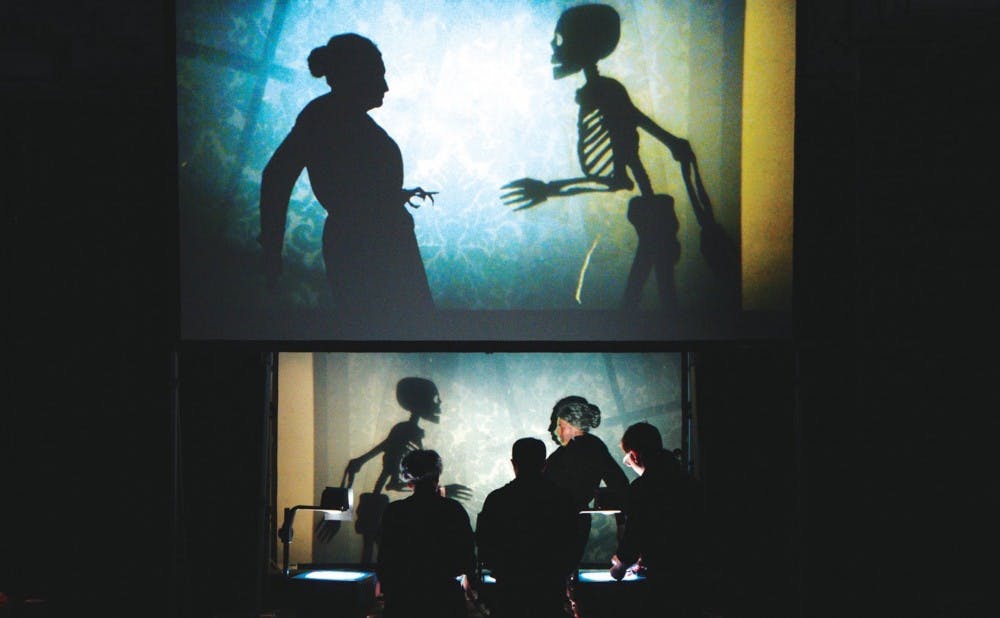This spring, the Chicago-based collective Manual Cinema is bringing an art form to campus that tends to be overlooked with regard to live performance: puppetry.
Be prepared, however, to cast aside any preconceived notions you might have about the medium, because Manual Cinema is far from the likes of “Avenue Q” or any of its puppet-related contemporaries. Instead, the group of performers, video producers and musicians that comprise Manual Cinema create a live product that is equal parts cinema, puppetry, theatre and music. Out of that combination arises an experience that can only be described as both enigmatic and beautifully imaginative.
Sarah Fornace, a director, puppeteer, choreographer and narrative designer for Manual Cinema, recalled that it all began in 2010 with an overhead projector — the sort of thing a third-grade teacher would use alongside worn transparencies and vis-à-vis markers. She was working at Redmoon Theater, a formerly Chicago-based puppetry company, with her friend Julia Miller, who is now a director, puppeteer and puppet designer at Manual Cinema.
“Julia found an overhead projector in her landlord’s garage, and she was like, ‘I want to make a show that’s a spiritual journey of a young woman with this overhead projector,’” Fornace said.
Fornace, though intrigued, was unable to work on the project at the time, so she told Miller to contact to her partner Drew Dir, a writer, director and illustrator. Miller also reached out to Kyle Vegter and Ben Kauffman, whom she knew as experimental musicians in the Chicago indie scene, and asked to sample some of their music for the budding puppet show. Vegter and Kauffman countered Miller’s request with something even better: Equipped with their knowledge of sound design and composition, they offered to compose an entire live score for the production.
And with that, Manual Cinema was born. The group took their show, titled “Lula Del Ray,” wherever they were allowed to show up — from bars to zine fests — and performed it as widely as possible. As their momentum increased and the group’s popularity blossomed, the quintet went back to the drawing board and crafted an entirely new show — a piece they named “Ada|Ava,” which will also be the first of Manual Cinema’s two performances on campus.
“Drew had this idea for a show that’s about death and these two twin sisters — it’s kind of Hitchcock inspired, like ‘Vertigo’ and some of his psychological thrillers,” Fornace said. “We used to live in the first story of a building in Chicago and we did it in our window on Halloween and put the speakers for the instruments in the bushes. People who were walking to go to the bars would stop and see the show.”
Those two shows, which Fornace cites as the group’s most widely performed pieces, proved to be the start of a wildly successful career for Manual Cinema. To date, they’ve produced over 20 different live performances and films, an immensely difficult feat when considering the amount of skill, effort and time required to execute their shows.
“We use overhead projectors, and we’ll put three or four of them all on one table and focused at a screen,” Fornace said. “We use printed acetate so we can get the colors and wallpapers for the background, and most of the solid objects or characters are made out of paper and appear in silhouettes. We also use our own shadows — when it’s a medium shot, it’s usually us in a costume playing a character, and when we cut to close-up that would be a paper puppet head.”
Fornace was also well-aware of her use of filmmaking lingo when talking about the technical aspects of Manual Cinema’s shows, and how that contributes even further to the idea that the company is creating films in their most bareboned, authentic form.
“The idea is we use cinematic language and the language of editing,” Fornace said. “Everything is composed of far shots, close-up shots [and] medium shots, and we use pieces of paper to open and close the light. We can do dissolves, cuts, rack focuses, even depth of field tricks with the overhead projectors.”
But whereas films are presented without any acknowledgements of their makers, Manual Cinema reminds the audience that the endlessly impassioned and hard-working individuals behind the scenes are an integral part of the theatrical and cinematic experience, too.
“Our shows have a giant screen above [the puppeteering], and you can just watch that screen and watch it like it’s a movie,” Fornace said. “But you can also look down and see the humans running around and grabbing hundreds of pieces of paper, playing instruments … the kind of mess [required] to make that clean image is present, so it makes the experience hopefully more strange and more live and more human, all around.”
It’s perhaps one of the most alluring aspects of a Manual Cinema performance: Not only are you are presented with a methodically written and performed puppet show, but you are also privy to an entirely different performance, composed of musicians, puppeteers, actors and artists working together within the same space and time.
“Media is designed to be so frictionless,” Fornace said. “You’re supposed to forget that it’s been designed to have some kind of impact on you, by some person out in the world. We’re trying to foreground that.”
Manual Cinema’s Duke Performance residency includes performances of “Ada/Ava” from Feb. 5 to Feb. 9 and performances of “No Blue Memories: The Life of Gwendolyn Brooks” from March 19 to March 23. In the days leading up to these performances, Manual Cinema will offer Duke students opportunities to learn about puppetry and theatre production from the artists themselves.
Get The Chronicle straight to your inbox
Sign up for our weekly newsletter. Cancel at any time.

